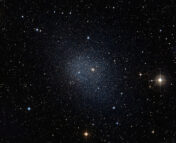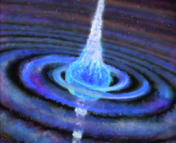Title: Radio Constraints on r-process Nucleosynthesis by Collapsars
Authors: Lee, Bartos, Cook et al.
First Author’s Institution: University of Florida
Status: Available on arxiv [open access]
Most elements in the periodic table originate in stars. Elements lighter than iron are stable and can be formed by nuclear fusion in stellar cores. Heavier elements have unstable nuclei, and require additional sources of energy to be formed. They are believed to originate in supernovae – the explosive deaths of stars with masses more than ten times that of the sun. However, even supernovae cannot produce the heaviest elements in the periodic table – the lanthanides and the actinides. The origin of these “heavy” elements (including gold and platinum!) is a long-standing mystery. Today’s authors use radio observations of collapsars – special types of supernovae – to constrain whether these elusive heavy elements can be formed in them.
r-process nucleosynthesis
The reason why lanthanides and actinides are so difficult to produce is because they are formed by a rare process called the “rapid-capture of neutrons” or the “r-process”. In this process, a free neutron is captured onto the nucleus of an atom, producing a nucleus with a higher atomic mass number. The problem is that free neutrons are inherently unstable particles that undergo the “beta-decay process” to form a proton, an electron and an antineutrino on a timescale of a few minutes. To efficiently activate the r-process, neutrons need to be captured faster than they decay. Therefore, a neutron-rich environment is needed. One such environment is formed during the explosive mergers of two neutron stars. So far, only one of these events has ever been observed – GW170817, which was detected in both gravitational and electromagnetic waves. However, other astrophysical explosions have also been proposed to produce neutron-rich ejecta, creating the conditions for r-process nucleosynthesis. One such explosion is known as a collapsar.
CollapsaRs
When massive stars (heavier than about 10 Msun) die, they can form neutron stars or black holes. If a neutron star is formed, most of the star’s outer layers are ejected at large velocities (~10000 km/s!) producing an energetic explosion we all know as a supernova. However, if a black hole is formed instead, most of the star can be gobbled up by the black hole, with very small amounts of material ejected. This changes if the star that formed the black hole had a mass of 20-30 Msun and was spinning really fast. Owing to the large angular momentum of this star, a larger fraction of its total mass can now be ejected. In fact, some of the ejected material can be accelerated to relativistic speeds (comparable to the speed of light), producing a beam of high energy photons called a Gamma Ray Burst (GRB). In addition to the GRB, the remaining ejected material which is not relativistic but is still moving really fast (~20000 km/s) can produce a regular supernova-like explosion. This explosion of a rapidly spinning massive star is known as a collapsar.
The ejected material from collapsars can power GRBs and supernovae. The material that falls into the black hole can also do interesting stuff. Because this material has large angular momentum, it can form a disk around the newly formed (baby) black hole. Most of this disk will be “accreted” by the black hole within a few seconds, destroying it, but the accretion process itself can eject a fraction of the disk in the form of winds. It turns out that these disk-winds are extremely rich in neutrons, and are thus viable sites for r-process nucleosynthesis (i.e formation of lanthanides and actinides). However, the signatures of this r-process are extremely difficult to observe as they can be masked by other features arising from the supernova explosion. To date, there has been no direct evidence of r-process nucleosynthesis in collapsars.
Radio
Radio observations provide one way to observe the signatures of this elusive r-process in collapsars. Several months after the supernova explosion, the disk-wind ejecta that is rich in lanthanides and actinides, interacts with the interstellar medium (ISM) surrounding the black hole. This produces a radio flare powered by a mechanism known as synchrotron emission. This flare peaks several months after the explosion, evolves slowly and can last for several years (Figure 1). Observations of such a radio flare in collapsars several years post-explosion can provide constraints on the amount of r-process elements synthesized in them.

Putting it all together!
The authors of today’s paper search for the late-time radio emission in collapsars. First, they select 11 collapsars that exploded in the last decade based on the GRBs detected by the Swift space satellite. They then looked for possible radio emission at the locations of these supernovae using data from the Karl G. Jansky Very Large Array radio telescopes. Unfortunately, they did not detect any late-time radio flares from these collapsars. However, based on the sensitivity of their data, they were able to place upper limits on the observed late-time radio emission. They then used theoretical models to derive upper limits on the total r-process material ejected by the collapsar. They found that the collapsars could not have ejected more than 0.2 Msun of r-process material. For reference, the neutron star merger GW170817 produced about 0.05 Msun of r-process material. This means that collapsars do not undergo significantly more r-process nucleosynthesis than the one neutron star merger we know of.
The authors note that the derived upper limits depend on assumptions of their models about the ISM density profiles, the energy distribution of electrons in the ISM and the velocity of the disk-wind ejecta. Despite these caveats, their observations place meaningful constraints on the amount of r-process material synthesized in collapsars. Future more sensitive radio observations can help confirm whether collapsars can synthesize the heaviest lanthanides or actinides or not. This will be important to identify whether collapsars, together with neutron star mergers account for the observed r-process elements in the universe, or whether we need to look for more r-process factories.
Edited by : Sasha Warren
Featured Image Credit: The Perimeter Institute





Very well written and informative!